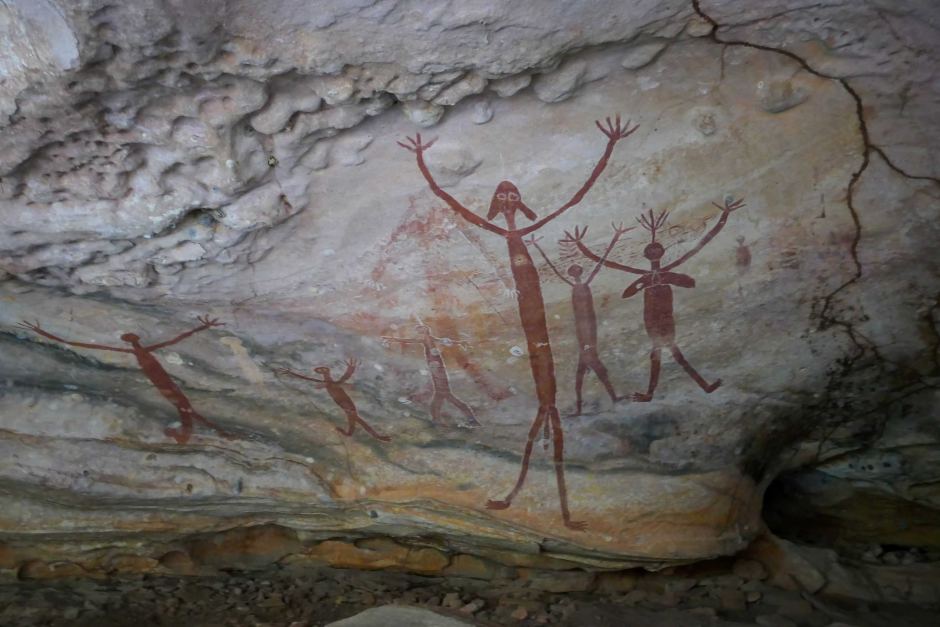Category: Indigenous Culture / Community and Society / Arts and Entertainment / Mining Industry / Mining Environmental Issues
Rare Indigenous 'library of rock art' under threat by gold mine, traditional owners say
Wednesday, 28 Sep 2016 09:06:30 | Mark Willacy

UNESCO regards the rock art as some of the most significant in the world. (ABC News: Mark Willacy)
Indigenous traditional owners from Queensland's Cape York are warning a proposed gold mine would potentially damage one of the world's oldest and most important collections of rock art.
The ABC can reveal the Queensland Government has granted an environmental authority for the mine which would involve the excavation of the Laura River, near the world-renowned Quinkan Aboriginal rock art galleries.
"This is all sandstone escarpments and it's very fragile," said Nash Snider, Laura Cultural Heritage Body chairman and traditional owner.
"Any movement in the ground can cause a ripple effect throughout this area. There's some other [rock art] galleries where there have already been effects from [mining] and they've fallen down on the ground."
Traditional owners and Laura community members have petitioned Queensland Premier Annastacia Palaszczuk to stop the mine, pointing out that UNESCO regards the Quinkan rock art as one of the 10 most significant bodies of rock art in the world.
Some of the art — which features colourful Quinkan spirits, human figures, crocodiles, kangaroos, birds, fish and eels — is tens of thousands of years old.
The art is being considered for National Heritage, which if successful, could pave the way for World Heritage listing.
But concerning many in Laura is the fact that the proponent of the gold mine is an Indigenous man, Danny O'Shane.
"It's just digging up the gravel, [the] riverbed, washing it through and extracting the gold, which isn't a lot of gold," Mr O'Shane told the ABC in Cairns.
Mr O'Shane and his partner have lodged a mining lease application with the Queensland Department of Natural Resources and Mines.
A Western Yalanji man, Mr O'Shane said he was a traditional owner of the country on which the gold operation would sit.
He denied the mine would harm the surrounding rock art sites. But he did admit it would not create much in the way of jobs.
"It'd only be a couple of jobs, it's a small operation, but a couple of jobs and people, you know, can make a reasonable living out of it."
Strongly opposed to the mine is Laura elder Roy Banjo, who leads tour groups to the Quinkan art galleries.
"It's all wrong. I don't like the idea of an excavator in the river and tourists going by and seeing this happening," said Mr Banjo.
"What sort of message are we trying to show people? Are we looking after country? Or are we trying to destroy it?"
The Queensland Environment Department issued the mine proponents an environmental authority, saying it did not receive any public objections.
But Indigenous representatives in Laura say they were unaware of any opportunity for the public to object.
Last month they sent a petition to Ms Palaszczuk warning the mine would vandalise one of Australia's national treasures.
"As traditional owners we have a responsibility to past and future generations to protect the cultural sites of our country. We feel that a mine in this location would cause significant damage to the cultural landscape, one which is currently under assessment for National Heritage listing and has been identified as a potential World Heritage Area," the petition stated.
Mr Snider added: "This is like a library of Cape York."
"[From the art] you learn how to hunt, you learn how to track, you learn how to be a healer. This is where the old people left behind the stories for us, as the next generation."
The mine still needs its lease confirmed by the Department of Natural Resources and Mines before excavation can begin.
"As part of the mining lease application process, native title must also be addressed," said a department spokesman.
"The assessment of the mining lease application requires the applicant to negotiate a native title agreement with local traditional owners for relevant native title issues including cultural heritage matters. These native title negotiations will provide an opportunity for the local traditional owners to raise any issues of concern with the mine proponent."
- About Us
- |
- Terms of Use
- |
-
 RSS
RSS - |
- Privacy Policy
- |
- Contact Us
- |
- Shanghai Call Center: 962288
- |
- Tip-off hotline: 52920043
- 沪ICP证:沪ICP备05050403号-1
- |
- 互联网新闻信息服务许可证:31120180004
- |
- 网络视听许可证:0909346
- |
- 广播电视节目制作许可证:沪字第354号
- |
- 增值电信业务经营许可证:沪B2-20120012
Copyright © 1999- Shanghai Daily. All rights reserved.Preferably viewed with Internet Explorer 8 or newer browsers.




 Send to Kindle
Send to Kindle


